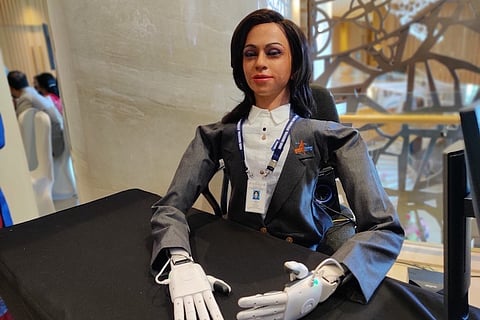

ISRO has presented a prototype of the half-humanoid, named Vyommitra, that will be sent into space as part of the unmanned Gaganyaan mission in December 2020. The humanoid will conduct experiments ahead of the Gaganyaan mission scheduled for 2022, in which humans will be sent into space.
ISRO officials told TNM that Vyommitra has anthropomorphic proportions with two arms, head and torso to mimic the crew that will be inside the module during the Gaganyaan mission. In the run-up to the ambitious manned mission, the space agency is expected to launch two-three unmanned missions in 2020 and 2021 with humanoids to test the human rating of the propulsion modules, including the crew module and the escape system in the event of any emergency in the spacecraft.
Meet Vyommitra, the half-humanoid prototype for #Gaganyaan unmanned mission @isro pic.twitter.com/m0Gx3A4Nas
— Sanyukta (@dramadhikari) January 22, 2020
Vyommitra has been configured to attain launch and orbital postures, respond to the environment in the crew module, generate warnings for CO2 and canister replacements. She can also operate switches, can receive voice commands and can respond via speech. The humanoid can speak in two languages and can lip-sync to speech.
The prototype was displayed at the Human Spaceflight and Exploration symposium, which is being held at Bengaluru's Conrad Hotel. Officials say this is not the final humanoid that will be sent during the unmanned mission, but simply a prototype.
The three-day exhibition held from January 22 to January 24 also had on display the food items that will be sent to space along with the astronauts who will be part of the Gaganyaan mission. This food is specially made by DRDO’s Defence Food Research Laboratory to suit the nutrition needs of the astronauts. Gaganyaan aims to send a three-member crew to space for a period of five to seven days. The spacecraft will be placed in a low earth orbit of 300-400km.
In 2018, ISRO had tested the crew module and the crew escape system. The test was over in 259 seconds, during which the crew escape system along with crew module soared skyward, then arced out over the Bay of Bengal and floated back to Earth under its parachutes about 2.9 km from Sriharikota. The crew module reached an altitude of nearly 2.7 km under the power of its seven specifically designed quick-acting solid motors to take away the crew module to a safe distance without exceeding the safe g-levels.
A model of the crew module
Earlier this month, ISRO Chief K Sivan had addressed the media and stated that four astronauts have been selected for India’s first manned mission Gaganyaan and that their training will start in the third week of January.
Gaganyaan is reported to have two unmanned and one manned flight to space. Six science experiments will be conducted, related to microgravity and bioscience, Sivan had said.